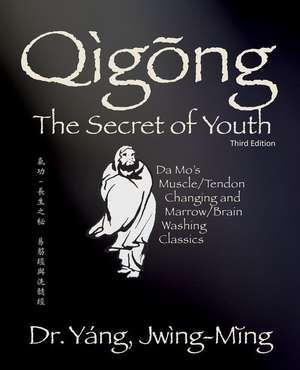Qigong Secret of Youth 3rd. Ed.: Qigong Foundation
Autor Jwing Ming Yangen Limba Engleză Paperback – 4 oct 2022
This third edition includes
- Updated pinyin that includes diacritical tonal marks (for proper pronunciation of Chinese words).
- Updated Chinese text character font (providing better readability).
Contents include
- General introduction qigong and practice
- Historical survey of Da Mo and his influence on qigong
- Buddhist and Daoist qigong
- Adjusting qi with kan and li
- Training theory of Muscle Tendon Changing
- Training theory of Marrow Brain Washing
Din seria Qigong Foundation
-
 Preț: 183.09 lei
Preț: 183.09 lei -
 Preț: 259.80 lei
Preț: 259.80 lei -
 Preț: 183.92 lei
Preț: 183.92 lei -
 Preț: 199.28 lei
Preț: 199.28 lei -
 Preț: 199.73 lei
Preț: 199.73 lei -
 Preț: 174.03 lei
Preț: 174.03 lei - 20%
 Preț: 121.13 lei
Preț: 121.13 lei
Preț: 183.53 lei
Nou
Puncte Express: 275
Preț estimativ în valută:
35.12€ • 36.76$ • 29.06£
35.12€ • 36.76$ • 29.06£
Carte disponibilă
Livrare economică 15-29 martie
Livrare express 04-08 martie pentru 41.44 lei
Preluare comenzi: 021 569.72.76
Specificații
ISBN-13: 9781594399077
ISBN-10: 1594399077
Pagini: 336
Dimensiuni: 188 x 233 x 21 mm
Greutate: 0.72 kg
Ediția:3rd edition
Editura: YMAA Publication Center
Seria Qigong Foundation
ISBN-10: 1594399077
Pagini: 336
Dimensiuni: 188 x 233 x 21 mm
Greutate: 0.72 kg
Ediția:3rd edition
Editura: YMAA Publication Center
Seria Qigong Foundation
Notă biografică
Dr. Yang, Jwing-Ming is a world-renowned author, scholar, and teacher of qigong and Chinese martial arts. He has been involved in martial arts since 1961 and maintains over 55 schools in 18 countries. Dr. Yang's writing and teaching include the subjects of qigong, kung fu, tai chi chuan, massage, and meditation. He is the author of over 35 books and 80 videos. Dr. Yang, Jwing-Ming teaches and resides at his YMAA Retreat Center in Miranda, California.
Cuprins
Foreword
Preface
Acknowledgments
About the Author
PART ONE GENERAL CONCEPTS
Chapter 1. Introduction
1.1 The Value of Tradition
1.2 What are Yìjīnjīng and Xǐsuǐjīng?
1.3 How the Yìjīnjīng and Xǐsuǐjīng Have Affected Chinese Culture?
1.4 The Value of the Yìjīnjīng and Xǐsuǐjīng in Today's World
1.5 How to Approach This Book
1.6 About This Book
Chapter 2. Historical Survey
2.1 Before Dámó
2.2 Dámó, the Yìjīnjīng and Xǐsuǐjīng
2.3 After Dámó
2.4 Stories
Chapter 3. Buddhist and Daoist Qìgōng
3.1 Buddhist and Daoist Qìgōng
3.2 The Differences between Buddhist and Daoist Qìgōng
3.3 The Two Major Styles of Daoist Qìgōng
Chapter 4. Kǎn and Lí
4.1 What are Kǎn and Lí?
4.2 Kǎn and Lí in Modern Science
4.3 The Keys to Kǎn and Lí Adjustment
4.4 Kǎn and Lí in Yìjīnjīng and Xǐsuǐjīng
PART TWO MUSCLE/TENDON CHANGING QÌGŌNG
Chapter 5.Theories and Principles
5.1 Introduction
5.2 General Concepts from Old Documents
5.3 Purposes, Advantages, and Disadvantages
5.4 Wàidān and Nèidān Yìjīnjīng
5.5 Wàizhuàng and Nèizhuàng
5.6 Iron Shirt and Golden Bell Cover
5.7 Training Theory
5.8 Other Concerns
Chapter 6. Yìjīnjīng Qìgōng Training
6.1 Important Training Rules
6.2 Who Can Train?
6.3 Keys to Training
6.4 When to Train?
6.5 Wàidān Yìjīnjīng Training
6.6 Nèidān Yìjīnjīng Training
6.7 Yìjīnjīng Training Schedule
6.8 Other Considerations
6.9 Conclusion
PART THREE MARROW/BRAIN WASHING QÌGŌNG
Chapter 7. Theories and Principles
7.1 Introduction
7.2 The Eight Vessels and Xǐsuǐjīng Qìgōng
7.3 Theories
7.4 Training Concepts
7.5 Wàidān and Nèidān Xǐsuǐjīng
Chapter 8. Xǐsuǐjīng Qìgōng Training
8.1 Introduction
8.2 Who is Qualified to Train?
8.3 Poetry
8.4 Refining the Essence and Converting It into Qì
8.5 Purifying Qì and Converting It into Shén
8.6 Washing the Marrow and Conquering the Hair
8.7 Refining Shén and Returning It to Nothingness
8.8 Crushing the Nothingness
PART FOUR QUESTIONS AND CONCLUSION
Chapter 9. Questions
Chapter 10. Conclusion
Appendix A. Herbal Prescriptions for Yìjīnjīng and Xǐsuǐjīng Training
Appendix B. Translation and Glossary of Chinese Terms
Index
Preface
Acknowledgments
About the Author
PART ONE GENERAL CONCEPTS
Chapter 1. Introduction
1.1 The Value of Tradition
1.2 What are Yìjīnjīng and Xǐsuǐjīng?
1.3 How the Yìjīnjīng and Xǐsuǐjīng Have Affected Chinese Culture?
1.4 The Value of the Yìjīnjīng and Xǐsuǐjīng in Today's World
1.5 How to Approach This Book
1.6 About This Book
Chapter 2. Historical Survey
2.1 Before Dámó
2.2 Dámó, the Yìjīnjīng and Xǐsuǐjīng
2.3 After Dámó
2.4 Stories
Chapter 3. Buddhist and Daoist Qìgōng
3.1 Buddhist and Daoist Qìgōng
3.2 The Differences between Buddhist and Daoist Qìgōng
3.3 The Two Major Styles of Daoist Qìgōng
Chapter 4. Kǎn and Lí
4.1 What are Kǎn and Lí?
4.2 Kǎn and Lí in Modern Science
4.3 The Keys to Kǎn and Lí Adjustment
4.4 Kǎn and Lí in Yìjīnjīng and Xǐsuǐjīng
PART TWO MUSCLE/TENDON CHANGING QÌGŌNG
Chapter 5.Theories and Principles
5.1 Introduction
5.2 General Concepts from Old Documents
5.3 Purposes, Advantages, and Disadvantages
5.4 Wàidān and Nèidān Yìjīnjīng
5.5 Wàizhuàng and Nèizhuàng
5.6 Iron Shirt and Golden Bell Cover
5.7 Training Theory
5.8 Other Concerns
Chapter 6. Yìjīnjīng Qìgōng Training
6.1 Important Training Rules
6.2 Who Can Train?
6.3 Keys to Training
6.4 When to Train?
6.5 Wàidān Yìjīnjīng Training
6.6 Nèidān Yìjīnjīng Training
6.7 Yìjīnjīng Training Schedule
6.8 Other Considerations
6.9 Conclusion
PART THREE MARROW/BRAIN WASHING QÌGŌNG
Chapter 7. Theories and Principles
7.1 Introduction
7.2 The Eight Vessels and Xǐsuǐjīng Qìgōng
7.3 Theories
7.4 Training Concepts
7.5 Wàidān and Nèidān Xǐsuǐjīng
Chapter 8. Xǐsuǐjīng Qìgōng Training
8.1 Introduction
8.2 Who is Qualified to Train?
8.3 Poetry
8.4 Refining the Essence and Converting It into Qì
8.5 Purifying Qì and Converting It into Shén
8.6 Washing the Marrow and Conquering the Hair
8.7 Refining Shén and Returning It to Nothingness
8.8 Crushing the Nothingness
PART FOUR QUESTIONS AND CONCLUSION
Chapter 9. Questions
Chapter 10. Conclusion
Appendix A. Herbal Prescriptions for Yìjīnjīng and Xǐsuǐjīng Training
Appendix B. Translation and Glossary of Chinese Terms
Index
